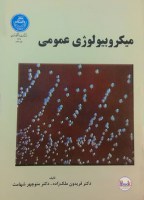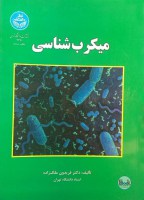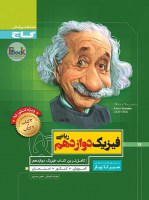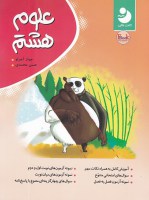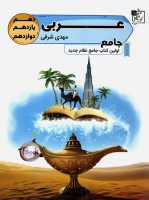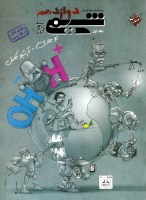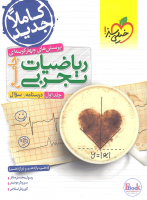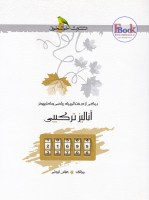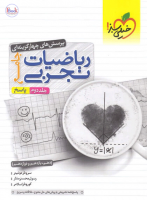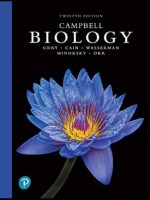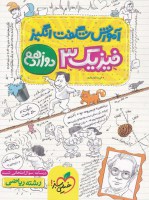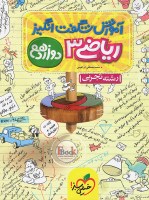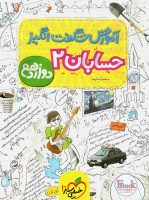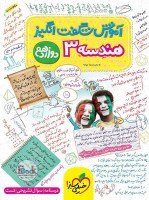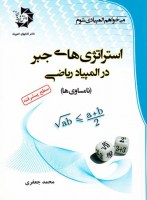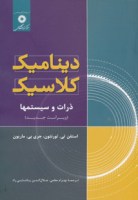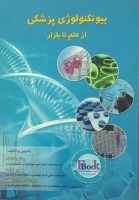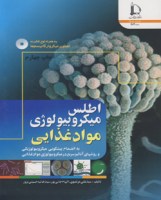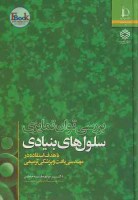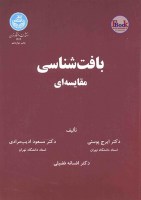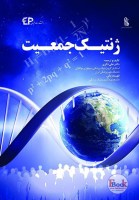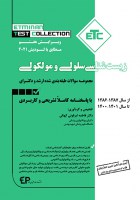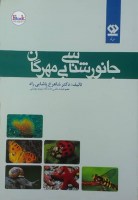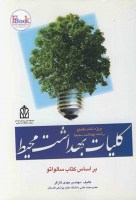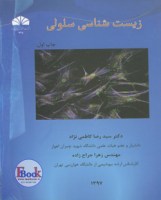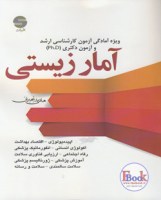دسته بندی
تست شیمی دوازدهم آرشیو کامل جلد اول
شامل درس و نکته های فصل 1 و 2 شیمی دوازدهم، پرسش های چهار گزینه ای همراه با پاسخ تشریحی.
1- ايستگاههای درس و نكته در پاسخنامهی تشریحی اين مجموعه، نكتههای كليدی و مهم در قالب ايستگاههای درس و نكته بيان شدهاند كه با مطالعهی دقيق اين ايستگاهها، عصارهی جان كتاب درسی همراه با نكتههای مستتر در آن به كالبد شما منتقل میشود. اين ايستگاهها در واقع جزوهی درسی شما هستند و با يادگيری آنها مطمئن باشيد كليهی مطالب و نكات لازم برای حل تستها را بلد هستيد.
2- تستهای بسيار مهم يا وی.آی. تی (Very Important Tests) حتماً میدانيد كه در بعضی اماكن، جايگاههای ويژهای را برای افراد بسيار مهم یعنی V.I.P يا Very Important Person مشخص میكنند. در اين كتاب نيز تستهای بسيار مهم را با علامتV.I.Tبه معنی Very Important Testsمشخص كردهايم. اين تستها كه با دقت و وسواس فراوان انتخاب شدهاند تستهایی را نشان میدهند كه حل آنها برای شما بسيار حساس، حياتی و مهم است و حل نكردن آنها مساوی فاجعه! اگر وقت كافی برای حل همهی تستهای اين كتاب را نداريد به شما اطمينان میدهيم كه با حل تستهای دارای اين علامت (كه صرف نظر از آزمونها، حدود یک سوم تستهای اين كتاب را شامل میشوند) تا حد زيادي به آمادگی لازم برای شركت در آزمونها میرسيد و نگران حل ساير تستها نباشيد.
3- تستهای دسا (دومين سطح اهميت) با توجه به فراوانی نسبتاً زياد تستهای هر بخش و با توجه به غُرزدن بعضیها كه حال ندارند همهی تستهای اين كتاب را حل كنند، تصميم گرفتم صرف نظر از تستهای مربوط به آزمونهای موجود در هر بخش، ساير تستها را به سه دسته تقسيم كنم. دستهی اول، تستهایV.I.T هستند كه در درجهی اول اهميت قرار دارند و حل آنها بر هر داوطلبی واجب است! دستهی دوم، تستهای دسا (دومين سطح اهميت) هستند كه پس از تستهای V.I.T در سطح دوم اهميت قرار دارند. دستهی سوم نيز تستهای بدون علامت هستند كه دارای پايينترين سطح اهميت میباشند.
4- طرح آموزش كارتونی در اين قسمت سعی كردهايم برخی از مطالب و مفاهيم کلیدی مطرح شده در كتاب درسی را به زبان كارتونی بيان كنيم تا اين مطالب و مفاهيم بهتر در ذهن و حافظهی خوانندگان اين كتاب جا بيفتند.
5- مناظره با دانشآموزان و سؤالهای متداول دانشآموزی یکی از مؤثرترين روشهای آموزش، روش مباحثه يا مناظرهی علمی است. در اين كتاب، گاهی مطالب به صورت يك بحث و مناظرهی زنده ارايه میشود. بدين ترتيب كه يك معلم و سه دانشآموز حضور دارند كه اين سه دانشآموز نمايندهی سه سطح آموزشی متفاوت هستند.
6- علايم كاريكاتوری ميزان سختی تستها در پاسخنامهی تشریحی اين كتاب، در كنار هر پاسخ تشریحی، علایمی را به كار بردهايم تا برای شما مشخص شود تستی را كه درست يا غلط زدهايد از نظر سختی در چه حدی است. (تست آسان، تست متوسط، تست سخت، تست خیلی سخت)
بیولوژی کمپبل 2020 زبان اصلی
Campbell Biology 11th Edition
About the Author
Lisa A. Urry
Lisa Urry (Chapter 1 and Units 1, 2, and 3) is Professor of Biology and Chair of the Biology Department at Mills College in Oakland, California, and a Visiting Scholar at the University of California, Berkeley. After graduating from Tufts University with a double major in biology and French, Lisa completed her Ph.D. in molecular and developmental biology at Massachusetts Institute of Technology (MIT) in the MIT/Woods Hole Oceanographic Institution Joint Program. She has published a number of research papers, most of them focused on gene expression during embryonic and larval development in sea urchins. Lisa has taught a variety of courses, from introductory biology to developmental biology and senior seminar. As a part of her mission to increase understanding of evolution, Lisa also teaches a nonmajors course called Evolution for Future Presidents and is on the Teacher Advisory Board for the Understanding Evolution website developed by the University of California Museum of Paleontology. Lisa is also deeply committed to promoting opportunities for women and underrepresented minorities in science.
Michael L. Cain
Michael Cain (Units 4, 5, and 8) is an ecologist and evolutionary biologist who is now writing full-time. Michael earned a joint degree in biology and math at Bowdoin College, an M.Sc. from Brown University, and a Ph.D. in ecology and evolutionary biology from Cornell University. As a faculty member at NEW! Mexico State University and Rose-Hulman Institute of Technology, he taught a wide range of courses, including introductory biology, ecology, evolution, botany, and conservation biology. Michael is the author of dozens of scientific papers on topics that include foraging behavior in insects and plants, long-distance seed dispersal, and speciation in crickets. Michael is also the lead author of an ecology textbook.
Steven A. Wasserman
Steve Wasserman (Unit 7) is Professor of Biology at the University of California, San Diego (UCSD). He earned his A.B. in biology from Harvard University and his Ph.D. in biological sciences from MIT. Through his research on regulatory pathway mechanisms in the fruit fly Drosophila, Steve has contributed to the fields of developmental biology, reproduction, and immunity. As a faculty member at the University of Texas Southwestern Medical Center and UCSD, he has taught genetics, development, and physiology to undergraduate, graduate, and medical students. He currently focuses on teaching introductory biology. He has also served as the research mentor for more than a dozen doctoral students and more than 50 aspiring scientists at the undergraduate and high school levels. Steve has been the recipient of distinguished scholar awards from both the Markey Charitable Trust and the David and Lucille Packard Foundation. In 2007, he received UCSD’s Distinguished Teaching Award for undergraduate teaching.
Peter V. Minorsky
Peter Minorsky (Unit 6) is Professor of Biology at Mercy College in New York, where he teaches introductory biology, evolution, ecology, and botany. He received his A.B. in biology from Vassar College and his Ph.D. in plant physiology from Cornell University. He is also the science writer for the journal Plant Physiology. After a postdoctoral fellowship at the University of Wisconsin at Madison, Peter taught at Kenyon College, Union College, Western Connecticut State University, and Vassar College. His research interests concern how plants sense environmental change. Peter received the 2008 Award for Teaching Excellence at Mercy College.
Jane B. Reece
The head of the author team for recent editions of CAMPBELL BIOLOGY, Jane Reece was Neil Campbell’s longtime collaborator. Earlier, Jane taught biology at Middlesex County College and Queensborough Community College. She holds an A.B. in biology from Harvard University, an M.S. in microbiology from Rutgers University, and a Ph.D. in bacteriology from the University of California, Berkeley. Jane’s research as a doctoral student and postdoctoral fellow focused on genetic recombination in bacteria. Besides her work on the Campbell textbooks for biology majors, she has been an author of Campbell Biology: Concepts & Connections, Campbell Essential Biology, and The World of the Cell.
Neil A. Campbell
Neil Campbell (1946–2004) combined the investigative nature of a research scientist with the soul of an experienced and caring teacher. He earned his M.A. in zoology from the University of California, Los Angeles, and his Ph.D. in plant biology from the University of California, Riverside, where he received the Distinguished Alumnus Award in 2001. Neil published numerous research articles on desert and coastal plants and how the sensitive plant (Mimosa) and other legumes move their leaves. His 30 years of teaching in diverse environments included introductory biology courses at Cornell University, Pomona College, and San Bernardino Valley College, where he received the college’s first Outstanding Professor Award in 1986. He was a visiting scholar in the Department of Botany and Plant Sciences at the University of California, Riverside. Neil was the lead author of Campbell Biology: Concepts & Connections, Campbell Essential Biology, and CAMPBELL BIOLOGY.
بررسی توان تمایزی سلول های بنیادی
کتاب بررسی توان تمایزی سلول های بنیادی نوشته دکتر مریم مقدم متین است. که در انتشارات دانشگاه فردوسی مشهد به چاپ رسیده است.
این کتاب 796 صفحه ای که در سال 1396 برای اولین بار چاپ شده است.
و در 16 مبحث به بررسی توان تمایزی سلول های بنیادی را مورد بررسی قرار می دهد:
فصل 1: مقدمه ای برسلول های بنیادی
فصل 2: سلول های بنیادی مزانشیمی
فصل 3: خون بند ناف منبعی غنی از سلول های بنیادی برای پیوند و درمان
فصل 4: مطالعه تومورهای سلول های جنسی و بررسی تمایز سلول های کارسینو مای شبه جنینی
فصل 5: تمایز سلول های بنیادی به دودمان عصبی
فصل 6: تمایز سلول های بنیادی به سلول های پوستی
فصل 7: تمایز سلول های بنیادی به سلول های استخوانی
فصل 8: تمایز سلول های بنیادی به کندروسیت ها
فصل 9: تمایز سلول بنیادی به سلول های عضله اسکلتی
فصل 10: تمایز سلول های بنیادی به سلول های اندوتلیال عروقی
فصل 11: تمایز سلول های بنیادی به سلول های خونی
فصل 12: تمایز سلول های بنیادی به سلول های سازنده شبکیه
فصل 13: تمایز سلول های بنیادی به سلول های زاینده جنسی
فصل 14: تمایز سلول های بنیادی به هپاتوسیت ها
فصل 15: تمایز سلول های بنیادی به سلول های تولید کننده انسولین
فصل 16: تمایز سلول های بنیادی به دودمان های تروفوبلاستی
در پایان نمایه برای مخاطبان کتاب آورده شده است .












